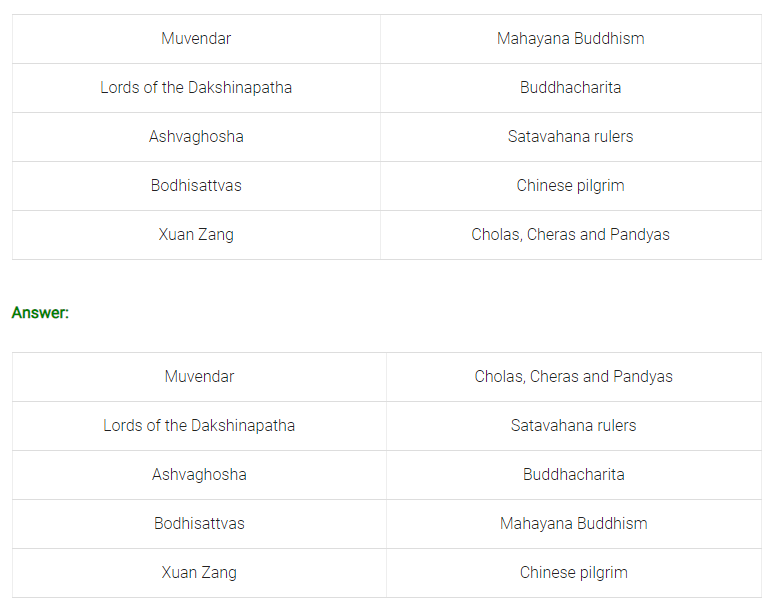NCERT Solutions for class 6 Social Studies History Chapter 9 Traders, Kings and Pilgrims
Let’s recall
Question 1. Match the following:

Question 2. Why did kings want to control the Silk Route?
Answer:- Because they could profit from the taxes, tributes, and gifts provided by traders and the people along the route, kings wanted to control the Silk Route.
Question 3. What kinds of evidence do historians use to find out about trade and trade routes?
Answer:- Historians utilize diverse evidence to find out about trade and trade routes:
- Archaeological Finds: Artifacts, like pottery and coins, unearthed from ancient sites provide insights into traded goods and routes.
- Ancient Texts: Historical documents, such as travelogues and trade contracts, offer firsthand accounts of trade activities.
- Trade Maps: Cartographic records illustrate established trade paths and connections between regions.
- Genetic and Isotopic Analysis: Studying DNA and isotopes in remains can reveal the movement of people, goods, and animals along trade routes.
Question 4. What were the main features of Bhakti?
Answer:- The main features of Bhakti were:-
- Bhakti is an important aspect of Hinduism.
- Bhakti was the method used to worship deities.
- Generally speaking, bhakti refers to a person’s devotion to their chosen deity.
- Anyone can pursue the path of bhakti, whether they are rich or poor, from the so-called “high” or “low” castes, male or female.
- This way placed more emphasis on personal devotion and worship of a god or goddess than it did on performing extravagant sacrifices.
- According to this belief, the deity will take any shape the devotee may choose if they worship their chosen deity with a pure heart. Therefore, the deity could be imagined as a lion, tree, human, or any other shape. After this theory became widely accepted, artists created stunning representations of these deities.
Let’s discuss
Question 5. Discuss the reasons why the Chinese pilgrims came to India.
Answer:- Chinese pilgrims journeyed to India for various reasons:
- Religious Pilgrimage: Seeking sacred Buddhist sites like Bodh Gaya and Sarnath, linked to Buddha’s life.
- Education: Accessing renowned Buddhist monasteries and scholars for advanced learning.
- Collection of Scriptures: Acquiring Buddhist texts unavailable in China.
- Exchange of Ideas: Sharing philosophical, cultural, and scientific knowledge between the two civilizations.
- Spread of Buddhism: Returning to China to propagate Buddhism, contributing to its growth and influence.
Question 6. Why do you think ordinary people were attracted to Bhakti?
Answer:-
- I believe that the reason common people were attracted to Bhakti was that Bhakt-saint preached in a language they could readily understand.
- The saints emphasised the importance of some deities’ worship, which later grew to be a key aspect of Hinduism.
- These gods and goddesses included Shiva, Vishnu, and Durga. Generally speaking, bhakti refers to a person’s devotion to the deity of their choice.
- Anyone can pursue the path of Bhakti, regardless of wealth, caste, or gender. This includes people from both the so-called “high” and “low” castes.
- The last goal of life, Moksha or salvation, was highlighted as being easily attainable.
Let’s do
Question 7. List five things that you buy from the market. Which of these are made in the city/village in which you live, and which are brought by traders from other areas?
Answer:- I don’t personally buy items, but here are five common things my parents buy from markets:
- Fruits and Vegetables: Some may be locally grown in the city/village, while others are brought from different regions.
- Clothing: Can be sourced locally or from distant manufacturing centers.
- Electronics: Often produced in various industrial areas and transported to markets.
- Household Items: Could include both locally crafted and imported products.
- Packaged Foods: Manufactured in different places and distributed to markets for sale.
Question 8. There are several major pilgrimages performed by people in India today. Find out about any one of them, and write a short description. (Hint: who can go on the pilgrimage — men, women or children? How long does it take? How do people travel? What do they take with them? What do they do when they reach the holy place? Do they bring anything back with them?)
Answer:- The Kumbh Mela, a significant pilgrimage in India, witnesses millions of participants. Men, women, and children from diverse backgrounds can join. Its duration varies, with the Ardh Kumbh occurring every six years and the Purna Kumbh every 12 years. Pilgrims travel by foot, vehicles, or trains, often carrying essentials like food, clothing, and religious items. Upon reaching the sacred riverbanks, they take ritual baths for spiritual purification, attend religious discourses, and seek blessings from sadhus. Many bring back holy water as a souvenir of their transformative experience.